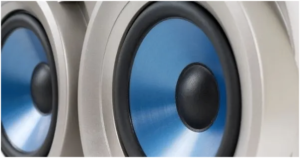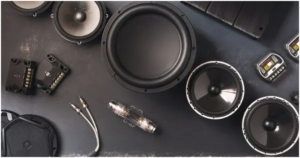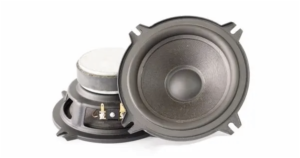There’s practically nothing more annoying than having your sound system all set up only to hear a constant hum from your subwoofer. Fortunately, while there are various possible causes for this, the remedies are not unduly hard.
A ground loop fault, generated noise from interrupted cables, troubles with other devices hooked into the same stream of outlets, or failures in the subwoofer itself are the most common causes of a 60hz subwoofer hum. Fixing this problem is dependent on determining the fundamental cause, thus trial and error is involved.

If your subwoofer is producing a dreaded hum, there are a few very common components you may look at.
After you’ve gone through the process of elimination, you should be able to figure out what’s causing the hum and how to fix it. Let’s look at the various sources of subwoofer hum and how to resolve the problem.
What is the source of the humming noise coming from my subwoofer?
You’ve spent a lot of time and effort researching the best sound equipment for your specific room, testing speaker placement, and determining the best subwoofer for low-frequency audio output.
However, when you switch on your gadgets, you hear a constant buzzing that you recognise as coming from your subwoofer. As aggravating as the hum is, not understanding what is producing the hum in the first place might be far more aggravating.
The most typical cause of a humming sound from a subwoofer is a ground loop caused by voltage variations between the subwoofer and your electric ground. Induced noise (typically from interrupted cables with insufficient shielding), other devices in the same power strip, or technical difficulties with the subwoofer are all possible culprits.
Of course, because there might be a wide range of solutions arising from a wide range of challenges, it’s critical to first have a better understanding of the issues themselves.
Then, knowing what you’re searching for, you may begin your trial and error process more precisely until you’ve pinpointed the cause of the subwoofer hum.
Regardless, you’ll want to figure out what’s producing the hum so you can fix it. You’ll relieve not have to listen to the 60hz hum emanating from your subwoofer any longer, if only for the satisfaction of eliminating this issue.
When you start streaming your favourite music or movies, you and your friends and family won’t have to ask, “What is that noise?”
Let’s take a deeper look at the most common reasons of buzzing in your subwoofer:
Error in the Ground Loop
One of the most common faults that might cause your subwoofer to hum is a ground loop mistake. While there are a few additional choices listed below, this is by far the most prevalent.
An inefficient stream of flowing electricity causes a ground loop fault. In a sense, the circuit becomes stuck or unable to flow through to your subwoofer, resulting in a continuous hum.
A ground loop error can occur when multiple devices are plugged into the same power outlet, when your device is plugged in the wrong way (the circuit needs to pass by changing direction and plugging in the cable “backward”), or when there are too many devices attempting to gain ground control from one device.
Attempting various techniques of detecting the ground loop fault and modifying your setup might therefore result in addressing these issues.
Disrupted Cables Cause Noise
Disrupted wires can also generate noise, causing your subwoofer to hum and grind your gears for what seems like hours.
Disruption of your cables might be caused by a similar cause, such as a ground loop fault, or it can cause by low quality cables in the first place. In either case, you may need to modify the way your cables are linked or invest in better tables.
A disrupted cable, for example, might indicate that the connection connecting your subwoofer to power is not receiving the proper quantity or flow of electricity to adequately power your subwoofer. This might possibly suggest that your cable’s shielding isn’t successfully shielding the passing signal.
You may also discover that the direction in which the electricity is flowing is ineffective for all components of your sound system, in which case you may need to adjust the directionality of the electric flow. This can be accomplished by more effectively reconnecting your cords.
In any case, it’s critical to determine when coaxial cables are required and to fix the cables themselves if they’re useless and causing the annoying subwoofer hum.
Other Devices on the Same Power Strip Have Issues
Another reason your subwoofer could be creating a humming noise, as previously stated, might be due to other devices using the same power strip.
Because the connections to your subwoofer will come from the same source or signal of power that affects the other devices on the same power strip, it’s crucial to inspect each component for proper connectivity.
If your cable box is hooked into the same power strip as your subwoofer and your cable box is battling for the ground or otherwise has a disturbed signal, the subwoofer may pick up on the affects of the disrupted signal and emit an irritating buzz or hum.
This is why it’s so important to double-check the subwoofer, its cords, the power supply, and any other devices connected into the same outlets or power strip as the subwoofer.
After all, a sound system setup necessitates exact connection in order for each component to be properly energised and ready for usage (without causing an irritating hum).
Malfunctioning Subwoofer Parts
Finally, while this isn’t usually the case, if your subwoofer is producing a persistent hum, it’s possible that the subwoofer is malfunctioning or has a component that needs to be replaced. Given the various interworking components of a subwoofer, this can be a little more difficult to figure out.
However, while you may want to blame all of the other components of your sound system setup, it may be wiser to concentrate on the piece of sound equipment that is genuinely at fault.
Knowing whether or not your subwoofer is the problem with your sound system might be difficult, but because there are so many factors that could cause this, it’s necessary to consider an upgrade or taking the subwoofer to an expert to be evaluated and perhaps corrected.
How to Fix a Subwoofer Hum?

Okay, so it’s fun to go over a list of reasons why your subwoofer is humming. But you’re probably more interested in finding a sensible remedy to the hum.
However, it is critical to remember that determining what is producing the subwoofer hum in the first place is the most significant step in resolving the problem.
Testing out the different potential faults that might be causing your subwoofer to emit a 60hz hum could take some time, given the amount of issues that could be causing it.
Knowing where to search for these flaws, on the other hand, can assist to prevent some of the trial and error attempts—or at the very least, offer you a few suggestions of where to start your trials.
With that in mind, let’s look at how to remedy a subwoofer hum based on what’s generating the problem in the first place.
Guide on 10 inch subwoofers: Cuzgeek.com
How to Fix a Subwoofer Hum Caused by a Ground Loop Error
There are a few options you may try if you have a ground loop fault that is causing your subwoofer to hum. If none of these options work. You’ll have to go on to the next trial and error step and try different options. Still, because a ground loop fault is one of the most prevalent reasons of subwoofer hum, here are some things to try:
Reverse the polarity of the situation
Attempting to reverse the polarity of the electric signal being communicated via your wires is one of the simplest ways to see if you can resolve a ground loop problem that is generating a subwoofer hum. While this may appear to be a complicated approach, it is actually rather easy if it works.
In this scenario, all you have to do is reverse the location of the subwoofer cable that is now connected in.
This entails turning the cable around and swapping the plugs in the left and right holes. If you’re using a three-pronged cable, this won’t work because you can’t just turn it over.
You might potentially address the disturbed flow of electrical current that is causing your subwoofer to hum by switching the polarity on a 2-pronged connection. While this outcome isn’t excessively complicated, it might be precisely what your subwoofer needs to stop buzzing.
Change the outlet where the subwoofer is plugged in.
Another option for resolving a ground loop mistake that may be causing your subwoofer to hum is to switch the outlet into which your subwoofer is plugged. This might imply a number of possibilities.
For starters, this might simply mean that you’ll use a different plug on the same power strip for your subwoofer. This might not help much because the power stream is so close together, but it might help if the problem is with the precise socket where you plugged your subwoofer in.
Another option is to switch out the power strips where your subwoofer is plugged in. This may necessitate the use of an extension cord to connect your subwoofer to another part of the room. While having to do this can be inconvenient, it will be preferable to the headache caused by the annoying subwoofer hum.
Other devices should be plugged into different outlets.
Finally, you can use the same outlet for your subwoofer by moving the plugs of other devices (which are plugged into the same power strip as your subwoofer) to different outlets. Trying to move all of the outlets except your subwoofer could take a lot of time and effort.
If you can’t plug your subwoofer into any other outlets and your other devices can reach them. You can try removing them.
The only difference is that you get to pick which gadget you wish to remove from the same power strip so they don’t “compete” for the same ground.
How to Fix Subwoofer Hum Caused by Induced Noise from Disrupted Cables
If faulty cables are causing your subwoofer to hum, it may be quite inconvenient given the quantity of cords in your sound system. As a result, it is best to start with one source and work your way backward as you try out other options. For example:
Starting with the subwoofer, test each cable.
If the disturbing cables are creating induced noise. You should examine the cables to determine which one is the source of the problem. However, until one wire is screaming at you, you may not be able to tell which one is the problem.
You may start at the subwoofer and work your way up to the power supply instead of taking numerous mistakes and testing (and then retesting) many of the same wires. You may accomplish this by replacing one cable at a time, inspecting the connection on that cable, and ensuring that it is not the source of the problem.
Of course, changing the cables might be costly, so you may want to reorganise the pieces you already have. You may then go on to the next wire in your connection arrangement if this one is still not the problem.
Upgrade your cables
If you still can’t figure out what’s wrong but believe it’s a cable issue, consider changing to higher-quality cables. This may be a somewhat more expensive option than you had hoped for, but if it means you won’t have to repair the parts on your subwoofer in the future, you’ll save money in the long term.
When it comes to replacing your cables, or picking the right ones for your subwoofer in the first place, you want to be sure they’re built of high-quality materials and have long-lasting shielding. This safeguards not just the cable, but also the equipment (including your subwoofer) to which it is connected.
How to Troubleshoot Problems with Other Devices in the Same Power Strip as Your Subwoofer
If trying alternative remedies for a ground loop problem and trial and error in changing or fixing the connections didn’t help, you could want to think about whether any other equipment linked to the same power strip is causing your subwoofer hum. If you believe this is doable, consider the following steps:
Remove one object at a time from the power switch.
To finish the elimination process, disconnect one item at a time from the power strip and test the subwoofer between each test to check whether it continues to hum.
When you unhook the cable box, for example, your subwoofer stops humming, you know the cable box’s connection is the source of the hum.
This may need adjusting the cable box’s connection, or you can choose to remove the subwoofer and attach it to a different outlet (as suggested above). It’s also possible that you’ve decided to fix the alternative device and its connection in your configuration.
Space the plugs farther apart
If you have a lot of gadgets connected to the same power strip, they may just want some “breathing room”. This can aid in the smoother flow of energy from one gadget to the next (or, in other words, from the source of the power to your subwoofer).
To avoid this problem, make sure your power strip has at least one unused socket between each item hooked in. This may necessitate the addition of a second power strip, or it may necessitate the selection of a different spot to plug in your subwoofer in the first place.
In any case, you’ll be giving your devices the space they need to send and receive the necessary signals.
Install an audio isolation transformer
You may assist to ease any troubles caused by other devices hook into the same power strip by plugging in an audio isolation transformer. Which isolates the specific signal that has to be routed to the subwoofer. As a result, your sub will receive the exact signal it requires without having to compete and buzz.
How to Repair Defective Subwoofer Parts That Lead your Subwoofer to Rumble

If none of the other components of your sound system are causing the subwoofer to hum (connections, cables, outlets, and other devices are all in good working order), you should suspect that your subwoofer is the source of the hum.
If the subwoofer’s internal workings are malfunctioning and generating a subwoofer hum, you can try the following:
Take your subwoofer to a technician
If you’re not sure what’s wrong with your subwoofer but know it’s not the speakers, you can have it fixed.
Hopefully, this will just need minor repairs. If the repair will be costly in the first place. You might want to consider upgrading your subwoofer to a higher-quality model.
Choose to listen to the hum
If you’re in a pinch and don’t have any other options. You might leave the hum on your subwoofer and repair the part later.
You always have the option to just leave it and cope with the discomfort if you’ve eliminated all other issues and are satisfied that the issue isn’t causing harm to other components in your sound system. Obviously, it was not a simplistic explanation.
Upgrade to a high-quality subwoofer as soon as possible to improve the overall sound quality of your system.
